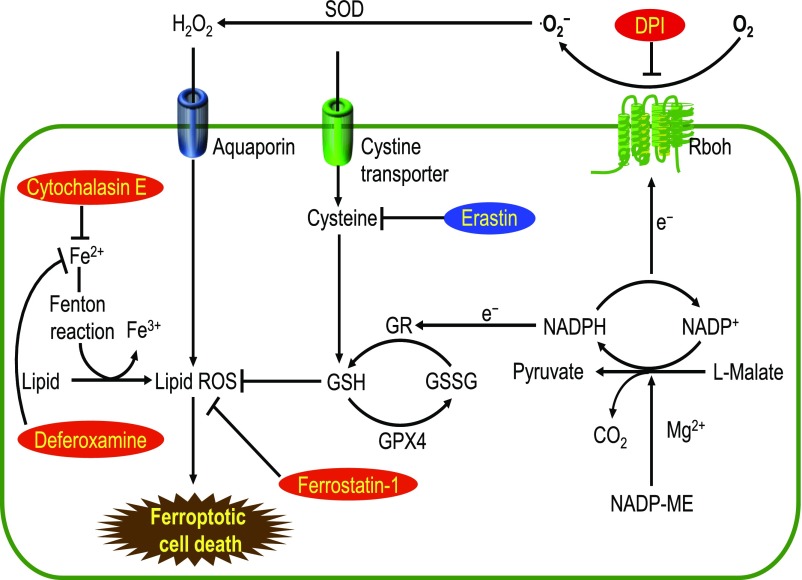Invasion of plant tissues by pathogens is well known to activate localized reactive oxygen species (ROS) production and cell death. However, the sources of ROS production and their role in triggering cell death are enigmatic. A recent study by Dangol et al. (2019) shows that, in rice (Oryza sativa), immunity-associated ROS production and cell death are both dependent on iron as cofactor.
Magnaporthe oryzae (rice blast fungus) is a hemibiotrophic fungal pathogen that causes major losses to rice harvests. Coevolution of M. oryzae with rice has led to the development of diverse resistance (R) genes in rice that mediate the detection of diverse effector proteins produced by the fungus. In compatible interactions, in the absence of recognition by a resistance protein, the effectors suppress immune responses, including ROS production, and M. oryzae successfully invades rice cells.
Dangol et al. (2019) investigated cellular responses in several rice-M. oryzae pairs with different compatibilities and identified a new player in R gene-mediated immunity, ferroptosis. This form of programmed cell death was described in mammalian cells just 6 years ago (Dixon et al., 2012) as a form of nonapoptotic iron-dependent cell death. It was discovered while investigating the effects of erastin, a compound that has many potential applications in medicine. In plants, iron homeostasis was shown to cover various roles in immunity (Aznar et al., 2015). Iron accumulation in wheat (Triticum aestivum) epidermis cells under attack by powdery mildew (Blumeria graminis f. sp. tritici) was also described previously, but without a link to cell death (Liu et al., 2007). Dangol et al. (2019) linked iron, ROS, and cell death and formalized the ferroptosis pathway in rice.
Dangol et al. (2019) showed that both iron and ROS accumulated in rice cells infected with incompatible M. oryzae strains. While a controlled ROS burst can be beneficial by serving as a distress signal, upon ROS and iron coaccumulation, hydrogen peroxide reacts with iron to produce highly toxic radicals and lipid peroxidation. Accumulation of lipid peroxides likely triggers cell death. The authors tested in rice treatments that blocked ferroptosis in mammalian cells. Both iron chelation (Deferoxamine, see figure), which inhibited cell death, and lipid peroxide scavenging (Ferrostatin-1, see figure) rendered resistant plants more susceptible to M. oryzae. Disrupting the actin microfilaments (Cytochalasin E, see figure) that guide vesicles laden with ROS and iron to sites of hyphal invasion had a similar effect. Erastin affected rice cells by inducing ferroptosis even during interactions with compatible strains of the pathogen. Erastin likely bypassed fungal effectors and also inhibited the production of glutathione. While fungal effectors are known to target NADP-malic enzyme for blocking ROS generation, the authors showed that NADP-malic enzyme and NADPH oxidase are also involved in ferroptosis.
Proposed Ferroptosis Model in Rice-M. oryzae Interactions. (Reprinted from Dangol et al. [2019], Figure 11).
Future research on the role of this iron-dependent form of cell death will show how widespread ferroptosis is in plants. Rice (M. oryzae) is the first plant pathosystem in which ferroptosis was detected. However, the accumulation of iron in response to powdery mildew was described in various monocots (Liu et al., 2007), suggesting that pathogen-induced ferroptosis is probably not restricted to rice.
Footnotes
Articles can be viewed without a subscription.
References
- Aznar A., Chen N.W.G., Thomine S., Dellagi A. (2015). Immunity to plant pathogens and iron homeostasis. Plant Sci. 240: 90–97. [DOI] [PubMed] [Google Scholar]
- Dangol S., Chen Y., Hwang B.K., Jwa N.-S. (2018). Iron- and reactive oxygen species-dependent ferroptotic cell death in rice-Magnaporthe oryzae interactions. Plant Cell 31: 189–209. [DOI] [PMC free article] [PubMed] [Google Scholar]
- Dixon S.J., Lemberg K.M., Lamprecht M.R., Skouta R., Zaitsev E.M., Gleason C.E., Patel D.N., Bauer A.J., Cantley A.M., Yang W.S., Morrison B. III, Stockwell B.R. (2012). Ferroptosis: An iron-dependent form of nonapoptotic cell death. Cell 149: 1060–1072. [DOI] [PMC free article] [PubMed] [Google Scholar]
- Liu G., Greenshields D.L., Sammynaiken R., Hirji R.N., Selvaraj G., Wei Y. (2007). Targeted alterations in iron homeostasis underlie plant defense responses. J. Cell Sci. 120: 596–605. [DOI] [PubMed] [Google Scholar]



